|

Basketball Coaching DVD's at Championship Productions
TRIANGLE OFFENSESince the 1990's no offense in basketball has proven its
worth as a championship offense like the triangle offense. This
offense, devised by the likes of Sam Barry and Tex Winter, found new
life in the 1990's and the 2000's with the championship runs by the
Chicago Bulls and the Los Angeles Lakers. The offensive concepts
that are in this offense have stood the test of time and are continuing
to be used at all levels of basketball with great success.
Advantages of the Triangle Offense
As mentioned earlier, the triangle offense is a great way to play a more
free-flowing style of offense that many set offenses lack while retaining a
degree of structure that free-lance offenses tend to lack. However, there
are more advantages that should be taken into consideration before running this
offense:
First, the triangle offense allows for multiple players to be posted up at
various times throughout the course of the offense. This puts perimeter
players on defense in a difficult situation if they have to play post defense
and have not worked on it in practice. The end result of a offensive
player in the post who knows how to play in the post versus a defensive player
in the post who has not worked on post defense a no contest.
Second, the spacing in the triangle offense is outstanding. Players are
spaced anywhere from 15 to 20 feet at any given time. This excellent
spacing makes the defense play far enough away from the other players to where
they are not in a position to help while also giving the offense the ability to
quickly snap passes between each other.
Finally, the triangle offense has multiple options and reads that lend it to
being a free-flowing style of offense. Since the offense has multiple
options in it, it becomes more difficult to scout. Also, the reads in the
offense allow the offense to take advantage of the defense whenever and wherever
necessary.
Disadvantages of the Triangle Offense
One of the main disadvantages of the triangle offense is that it requires quick
decision-making based on reading the defense. In the NBA, the triangle
offense worked well because of the abilities of the players running it to make
decisions in a timely manner. This was because of the 24-second shot clock
in part, but it also had to do with the need to beat the defense with an
excellent sense of timing and to run the offense quicker than the defense can
react to it.
The second big disadvantage of the triangle offense is that the offense is
perimeter oriented. That is to say that the offense can put players in the
position of having to shoot jump shots from the perimeter if they cannot
penetrate the defense with an entry pass to the post. If penetration does
not occur, players must be capable of scoring from the outside (i.e. Michael
Jordan and Kobe Bryant).
Finally, the triangle offense also has the disadvantage when it comes to
help-side rebounding. In many cases, the offense is focused so much on one
side of the floor that when a shot is taken, it becomes difficult to rebound on
the other side. Seventy percent of shots taken on one side of the floor
are rebounded on the other so it will become important to your team to work on
weak-side rebounding on all shots and to get everyone into a position where they
can rebound on the ball side as well as the help side.
Entries into the Triangle Offense
Many teams that like to run the triangle offense will use a two-guard front.
This front is very beneficial to a team if they do not have a point guard.
It also allows for an offense to post up any one of the five players on the
floor. That front will be illustrated later when discussing a pressure
release and the "blind pig" that that can be used against pressure defenses.
However, I am partial to the 1-4 high alignment because it allows an offense to
better handle defensive pressure and, unlike the two-guard front alignment, has
a safety in the event a pass is intercepted. For all of these entries that
are presented, I will use the 1-4 high alignment.
The 1-4 high alignment also gives us the opportunity to run the offense on
either side of the floor immediately. In essence, there are 12 wing
entries into the triangle offense if you count both sides. We also can run
the solo cut options that will be illustrated and explained later in this
article on either side of the floor.
The first entry presented is a pass from the point guard to the wing as is
illustrated in Diagrams 1 and 3. In Diagram 1, the point guard speed cuts
to the ball-side corner while #3 fills the point with a cut that breaks the
three-point line twice and influences his defender toward the basket before
cutting to the point. In Diagram 1, #5 flashes to the ball side post while
#4 cuts away to the help-side short corner. In Diagram 3, #4 rolls down to
the ball-side post while #5 goes to the help-side short corner. Diagrams 2
and 4 show the aftermath of the entries illustrated in Diagrams 1 and 3
respectively.
As a point of emphasis, it is important that whichever post is posting up in the
ball-side post must be on the line of deployment. The line of deployment
is the line that connects the ball at the wing to the center of the basket.
This way, the post man's defender has to make the decision as to how he will
guard him and, no matter what the decision is, the defensive player will be
wrong.
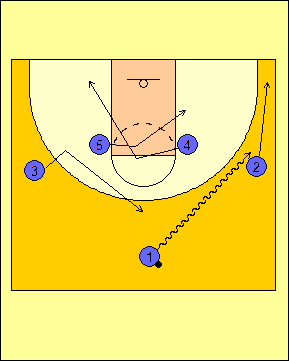
Diagram 5 |
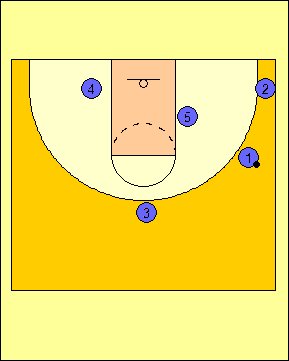
Diagram 6 |
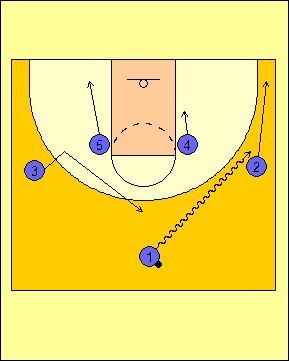
Diagram 7 |
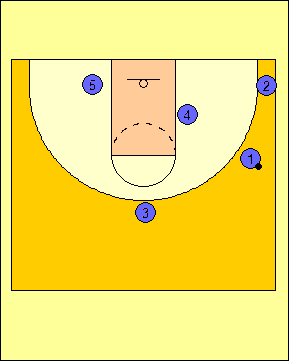
Diagram 8 |
We can also set up the offense by getting the
opposite wing to fill the ball-side corner and the point guard to
fill the point. Diagrams 9 and 10 show #4 posting up and the
opposite wing (in this instance, #3) filling the corner thanks to a
rear screen from #5. Diagrams 11 and 12 show #5 posting up and
#4 setting the rear screen.
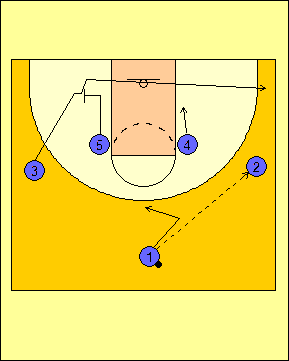
Diagram 9 |
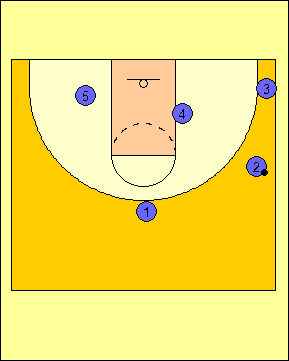
Diagram 10 |
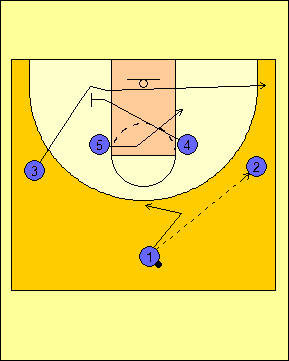
Diagram 11 |
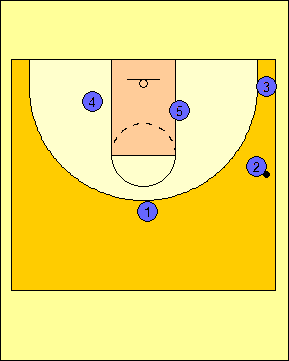
Diagram 12 |
Once the offense is set, we have four options that
we can run from this alignment that are illustrated in Diagram 13:
the post entry option, the point entry option, the high post entry
option, and the corner entry option. We will look to run those
options in the order in which they are presented.
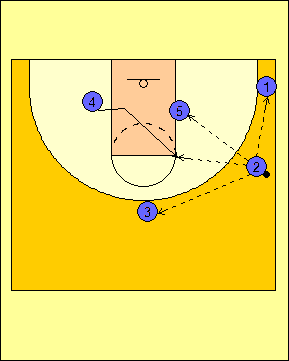
Diagram 13 |
Read the full article and many others by signing up for a Coach Peel
Basketball membership today.
Membership Subscription with Monthly Payments: $6.00 per
month
Membership Subscription with Quarterly Payments:
$15.00 per quarter (save over 16.6%)
Membership Subscription with Annual Payments: $50.00 per
year (save over 30.5% & get your first 30 days free!)

© 2010-2017 Alan Peel Enterprises
|